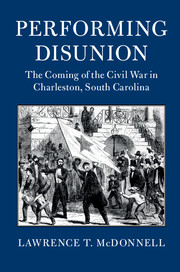Epilogue
Published online by Cambridge University Press: 08 June 2018
Summary
HISTORY, n. An account mostly false, of events mostly unimportant … brought about by rulers mostly knaves, and soldiers mostly fools.
Ambrose Bierce, The Devil's Dictionary
Eventually the Vigilant Rifles got their guns, and their members found occasion to use them, though not at Fort Sumter, and not as Vigilant Rifles. Mustered into the Fourth Brigade of South Carolina Infantry, the Vigilants were stationed out of harm's way on Morris Island during the crisis of April 1861. Thereafter, they returned to the city and were dispersed among a host of units. Officially, they became a company of the 1st South Carolina Militia Artillery, under Sam Tupper's command, patrolling the lowcountry to no purpose. Whenever Yankees approached, these Minute Men were always a minute too late to engage them.
Others found different routes to Appomattox. From the start, not a few volunteers thought Tupper too punctilious, or saw the shift from firefighting to military service as a threat to personal independence and manly self- portrayal. A fraction told their captain what he could do with his rulebook and transferred out, often to other artillery units dominated by Charleston firemen. In or out, all moved in lockstep toward the ruin of their world. Etsell Adams, master to twelve slaves and senior partner in a thriving commission merchant business, rose to the rank of corporal in the 12th South Carolina Volunteers (SCV) before he was wounded and captured on the second day at Gettysburg. Private James Baker, a cotton broker with a personal estate worth $10,000 fell into Yankee hands during service with the 1st SCV along Virginia's North Anna River in May 1864. Edwin Calder, a collector of Federal customs before secession, mustered in as a private with the 25th SCV, fighting Federals for almost four years before his capture at Fort Fisher in 1865. Clerks William K. Browne and John Humphreys and engineer- architect Edward B. White all served in the siege of Charleston. The pen- pushers, both privates, suffered wounds, disease, and capture, like so many of their fellows. White rose to the rank of colonel, in charge of heavy artillery in the Charleston area, just before the city fell.
- Type
- Chapter
- Information
- Performing DisunionThe Coming of the Civil War in Charleston, South Carolina, pp. 400 - 404Publisher: Cambridge University PressPrint publication year: 2018



